
Wolf–Rayet stars, often abbreviated as WR stars, are a rare heterogeneous set of stars with unusual spectra showing prominent broad emission lines of ionised helium and highly ionised nitrogen or carbon. The spectra indicate very high surface enhancement of heavy elements, depletion of hydrogen, and strong stellar winds. The surface temperatures of known Wolf–Rayet stars range from 20,000 K to around 210,000 K, hotter than almost all other kinds of stars. They were previously called W-type stars referring to their spectral classification.

WR 136 is a Wolf–Rayet star located in the constellation Cygnus. It is in the center of the Crescent Nebula. Its age is estimated to be around 4.7 million years and it is nearing the end of its life. Within a few hundred thousand years, it is expected to explode as a supernova.

HD 5980 is a multiple star system on the outskirts of NGC 346 in the Small Magellanic Cloud (SMC) and is one of the brightest stars in the SMC.

AB7, also known as SMC WR7, is a binary star in the Small Magellanic Cloud. A Wolf–Rayet star and a supergiant companion of spectral type O orbit in a period of 19.56 days. The system is surrounded by a ring-shaped nebula known as a bubble nebula.

WR 22, also known as V429 Carinae or HR 4188, is an eclipsing binary star system in the constellation Carina. The system contains a Wolf-Rayet (WR) star that is one of the most massive and most luminous stars known, and is also a bright X-ray source due to colliding winds with a less massive O class companion. Its eclipsing nature and apparent magnitude make it very useful for constraining the properties of luminous hydrogen-rich WR stars.
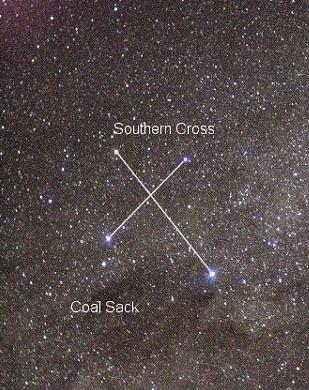
WR 46 is a Wolf-Rayet star in the constellation of the Southern Cross of apparent magnitude +10.8. It is located at 55 arcmin north of Theta2 Crucis. The star is a member of the distant stellar association Cru OB4, and is around 2,900 parsecs or 9,300 light years from the Solar System.
WR 147 is a multiple star system in the constellation of Cygnus. The system is extremely reddened by interstellar extinction – that is, dust in front of the star scatters much of the blue light coming from WR 147, leaving the star appearing reddish.

WR 148 is a spectroscopic binary in the constellation Cygnus. The primary star is a Wolf–Rayet star and one of the most luminous stars known. The secondary has been suspected of being a stellar-mass black hole but may be a class O main sequence star.

Theta Muscae is a multiple star system in the southern constellation Musca, containing a Wolf-Rayet star and two massive companions. With an apparent magnitude of 5.5, it is the second-brightest Wolf–Rayet star in the sky, although much of the visual brightness comes from the massive companions and it is not one of the closest of its type.
WR 142 is a Wolf-Rayet star in the constellation Cygnus, an extremely rare star on the WO oxygen sequence. It is a luminous and very hot star, highly evolved and close to exploding as a supernova. It is suspected to be a binary star with a companion orbiting about 1 AU away.
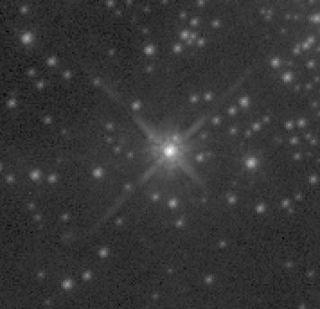
Melnick 34, also called BAT99-116, is a binary Wolf–Rayet star near R136 in the 30 Doradus complex in the Large Magellanic Cloud. Both components are amongst the most massive and most luminous stars known, and the system is the most massive known binary system.
HD 93403 is a spectroscopic binary containing two highly luminous hot blue stars. It is 10,000 light years away in the Carina Nebula in the constellation Carina. It appears to have spectral type O5.5III, but this is composed of two spectra from a blue supergiant and blue main sequence star of spectral type O5.5I and O7V respectively. The two stars orbit every 15 days with a separation that varies from 93 R☉ to 149 R☉. The binary is shedding mass at the high rate of 0.0005 M☉ per year.

WR 102 is a Wolf–Rayet star in the constellation Sagittarius, an extremely rare star on the WO oxygen sequence. It is a luminous and very hot star, highly evolved and close to exploding as a supernova.

CD Crucis, also known as HD 311884, is an eclipsing binary star system in the constellation Crux. It is around 14,000 light years away near the faint open cluster Hogg 15. The binary contains a Wolf–Rayet star and is also known as WR 47.

AB8, also known as SMC WR8, is a binary star in the Small Magellanic Cloud (SMC). A Wolf-Rayet star and a main sequence companion of spectral type O orbit in a period of 16.638 days. It is one of only nine known WO stars, the only Wolf-Rayet star in the SMC not on the nitrogen sequence, and the only Wolf-Rayet star in the SMC outside the main bar.
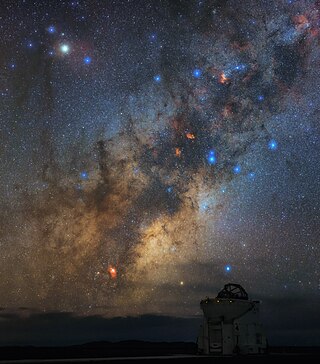
WR 93b is a Wolf-Rayet star in the constellation Scorpius, an extremely rare star on the WO oxygen sequence. It appears near NGC 6357 in the tail of the scorpion.
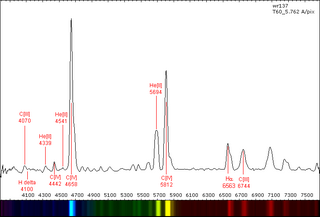
WR 137 is a variable Wolf-Rayet star located around 6,000 light years away from Earth in the constellation of Cygnus.

R145 is a spectroscopic binary star in the Tarantula Nebula in the Large Magellanic Cloud located in the constellation Dorado. Both components are amongst the most luminous known.

WR 9 is a spectroscopic binary in the constellation Puppis consisting of a Wolf-Rayet star and a class O star. It is around 12,000 light years away.
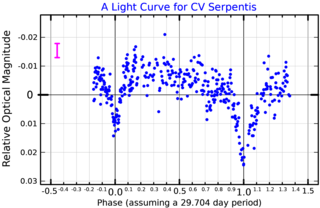
CV Serpentis is a binary star system in the equatorial constellation of Serpens. It is a detached eclipsing binary with an orbital period of 29.7 days. The system includes a Wolf–Rayet (WR) star with the identifier WR 113. The system is located at a distance of approximately 6,700 light years from the Sun based on parallax measurements. It is a member of the Serpens OB2 association of co-moving stars.



















